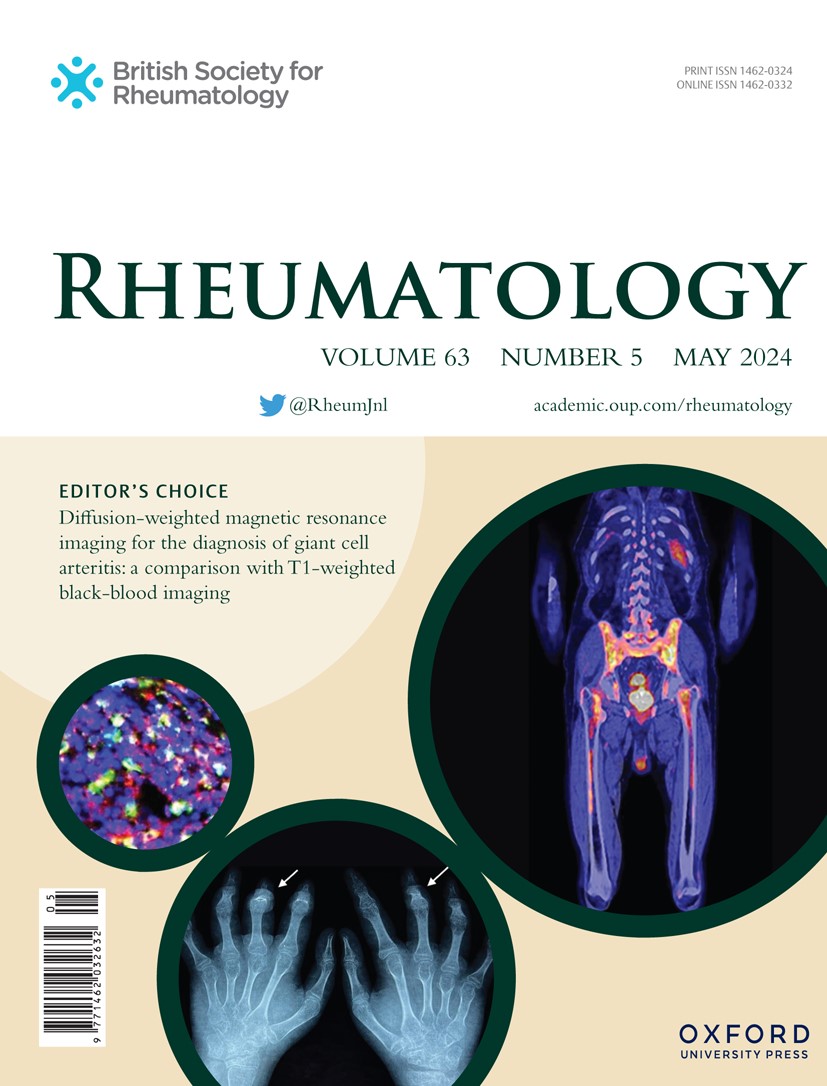Modified lung ultrasound score to assess extent and prognosis in systemic autoimmune rheumatic disease-associated interstitial lung disease
IF 4.4
2区 医学
Q1 RHEUMATOLOGY
引用次数: 0
Abstract
Objectives Lung ultrasound (LUS) assesses lung lesion severity in systemic autoimmune rheumatic disease-associated interstitial lung disease (SARD-ILD). The ultrasound manifestations of SARD-ILD include pleural line (PL) abnormalities and heterogeneous B-line (BL) distribution. We aimed to investigate the feasibility of a modified ultrasound scoring system based on refined grading of BL and PL features in patients with SARD-ILD, to determine whether BLs and PLs can effectively reflect ILD patterns across different lung compartments. METHODS 195 Patients with nine SARD-ILDs underwent LUS-chest high-resolution computed tomography (HRCT) pairing was used to determine BLs and PLs diagnostic performance for ILD patterns characterization. BL and PL scores for both were refined to obtain the modified LUS score. Correlations with the Warrick score, ILD-GAP, and severity based on forced vital capacity (FVC) were analyzed, receiver operating characteristic (ROC) were calculated. RESULTS Using HRCT as a criterion, BLs and PLs showed high concordance for diagnosing ground-glass opacity (kappa = 0.606) and reticular opacity (kappa = 0.743), respectively. Modified LUS scores were positively correlated with the Warrick score (r = 0.863; p< 0.001) and ILD-GAP (r = 0.613; p< 0.005). ROC analysis revealed optimal modified LUS score thresholds of 11.5 for identifying cases with high fibrosis burden (Warrick score >8), 18.5 for high mortality risk (ILD-GAP ≥2), and 9.5 for severe functional impairment (FVC% predicted <60%). CONCLUSION BLs and PLs have different diagnostic significances for different ILD patterns. The modified LUS scoring system reliably assesses lesion severity and suggesting poor prognosis in SARD-ILD compared with computed tomography scan.改良肺超声评分评估系统性自身免疫性风湿病相关间质性肺疾病的程度和预后
目的肺超声(LUS)评估系统性自身免疫性风湿病相关间质性肺疾病(SARD-ILD)肺部病变严重程度。SARD-ILD的超声表现包括胸膜线(PL)异常和b线(BL)分布不均。我们的目的是研究一种基于SARD-ILD患者BL和PL特征精细分级的改良超声评分系统的可行性,以确定BLs和PLs是否能有效反映不同肺间室的ILD模式。方法对195例患有9例sard -ILD的患者进行lus -胸部高分辨率计算机断层扫描(HRCT)配对,以确定BLs和PLs对ILD模式特征的诊断性能。对两者的BL和PL评分进行细化,得到修改后的LUS评分。分析与Warrick评分、ILD-GAP和基于强迫肺活量(FVC)的严重程度的相关性,计算受试者工作特征(ROC)。结果以HRCT为标准,BLs和PLs对毛玻璃混浊(kappa = 0.606)和网状混浊(kappa = 0.743)的诊断一致性较高。改良LUS评分与Warrick评分(r = 0.863; p< 0.001)和ILD-GAP (r = 0.613; p< 0.005)呈正相关。ROC分析显示,确定高纤维化负担病例的最佳修正LUS评分阈值为11.5 (Warrick评分&;gt;8),高死亡风险病例为18.5 (ILD-GAP≥2),严重功能障碍病例为9.5 (FVC%预测&;lt;60%)。结论BLs和PLs对不同类型ILD的诊断意义不同。与计算机断层扫描相比,改进的LUS评分系统可靠地评估了SARD-ILD的病变严重程度并提示预后不良。
本文章由计算机程序翻译,如有差异,请以英文原文为准。
求助全文
约1分钟内获得全文
求助全文
来源期刊

Rheumatology
医学-风湿病学
CiteScore
9.40
自引率
7.30%
发文量
1091
审稿时长
2 months
期刊介绍:
Rheumatology strives to support research and discovery by publishing the highest quality original scientific papers with a focus on basic, clinical and translational research. The journal’s subject areas cover a wide range of paediatric and adult rheumatological conditions from an international perspective. It is an official journal of the British Society for Rheumatology, published by Oxford University Press.
Rheumatology publishes original articles, reviews, editorials, guidelines, concise reports, meta-analyses, original case reports, clinical vignettes, letters and matters arising from published material. The journal takes pride in serving the global rheumatology community, with a focus on high societal impact in the form of podcasts, videos and extended social media presence, and utilizing metrics such as Altmetric. Keep up to date by following the journal on Twitter @RheumJnl.
 求助内容:
求助内容: 应助结果提醒方式:
应助结果提醒方式:


